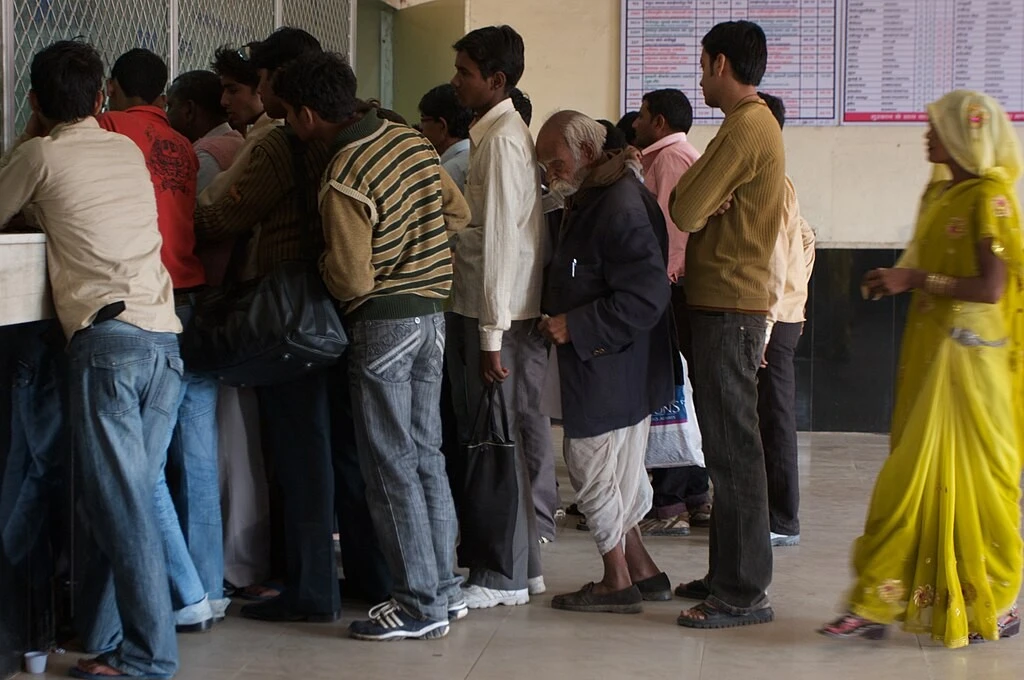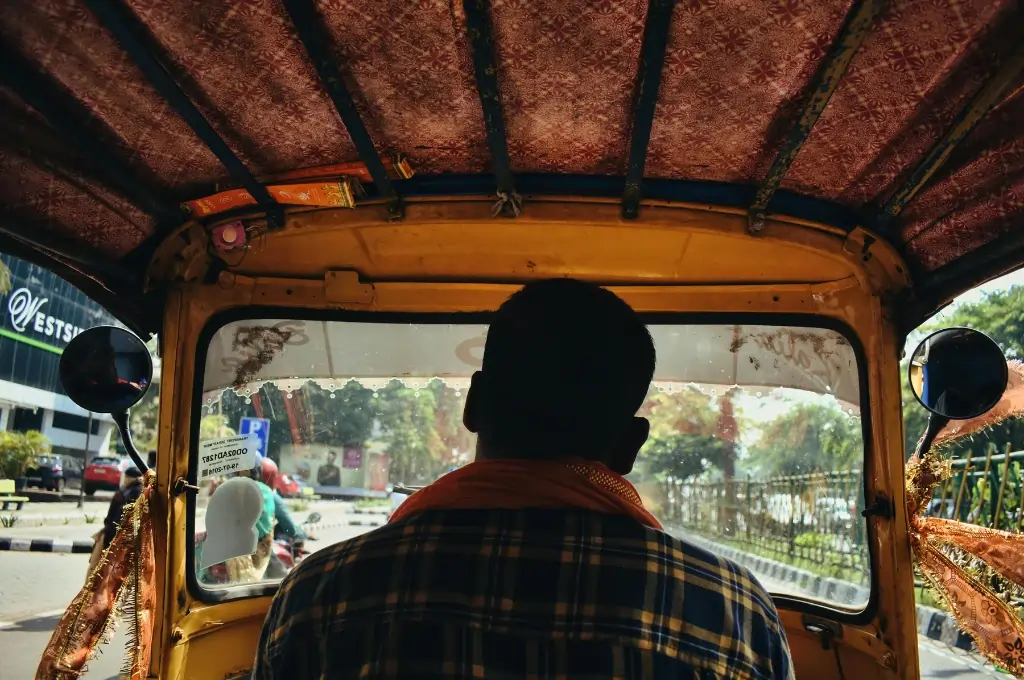As the second wave of the COVID-19 pandemic ravaged urban and rural India alike, governments, civil society, and communities had to grapple with an overburdened healthcare system, lack of basic necessities such as food and medical support, loss of livelihoods, vaccine hesitancy, and more.
In response to this crisis, on May 26th, 2021, 56 civil society organisations (CSOs) from across the country met online on invitation from Participatory Research in Asia (PRIA), Centre for Youth and Social Development (CYSD), Sahbhagi Shikshan Kendra (SSK), Samarthan, and Unnati. Their objective was to discuss the COVID-19 situation and understand the emerging needs of CSOs and their response to the pandemic. The idea of launching a survey to gain a more accurate understanding of the situation was mooted. This was perceived as particularly relevant in light of the changes in the regulatory environment, particularly amendments to the Foreign Contribution (Regulation) Act, which adversely affected the funds and resources available to small- and medium-sized organisations. The survey—Civil society support to COVID-19 affected families—was launched by a team at PRIA. A total of 583 responses were received from CSOs working in 26 states and 4 union territories, out of which 577 responses were considered for analysis.
The CSOs that participated in the survey are predominantly small and medium-sized organisations. More than two-thirds of the respondents work in one to five districts, with an annual budget of less than INR 1 crore. One-fifth of the respondents have an annual budget that is more than INR 1 crore, and only a few respondents have an annual budget greater than INR 5 crore.

Let’s talk impact. How did CSOs support communities?
CSOs have played an active role in mitigating the adverse effects faced by thousands of families due to the pandemic. Across survey respondents, 384 CSOs (or 66 percent) were able to reach out and provide support to 48,18,761 families. Nearly half of the respondents were able to support between 100 and 1,000 families. Six percent were able to reach out and provide support to more than 10,000 families.
1. Personal hygiene materials, food, and medical support
Nearly 91 percent of the respondents distributed personal hygiene items such as masks, sanitisers, sanitary pads, gloves, and PPE kits to community members and frontline workers. Seventy-eight percent distributed food—dry rations, cooked food, or both. And, 73 percent provided various kinds of medical supplies—medicines, oxygen cylinders and concentrators, and oximeters.
CSOs helped arrange COVID-19 tests, blood plasma, and hospitalisation of patients, as needed. One-fifth of the respondents also helped organise quarantine centres, encouraged vaccination, and helped conduct vaccination drives. Additionally, more than half of them offered psychosocial counselling and emotional support to distressed families and communities.
Approximately one-fifth of the respondents offered cash support to families in light of job losses and loss of income sources due to pandemic-related lockdowns and curfews.
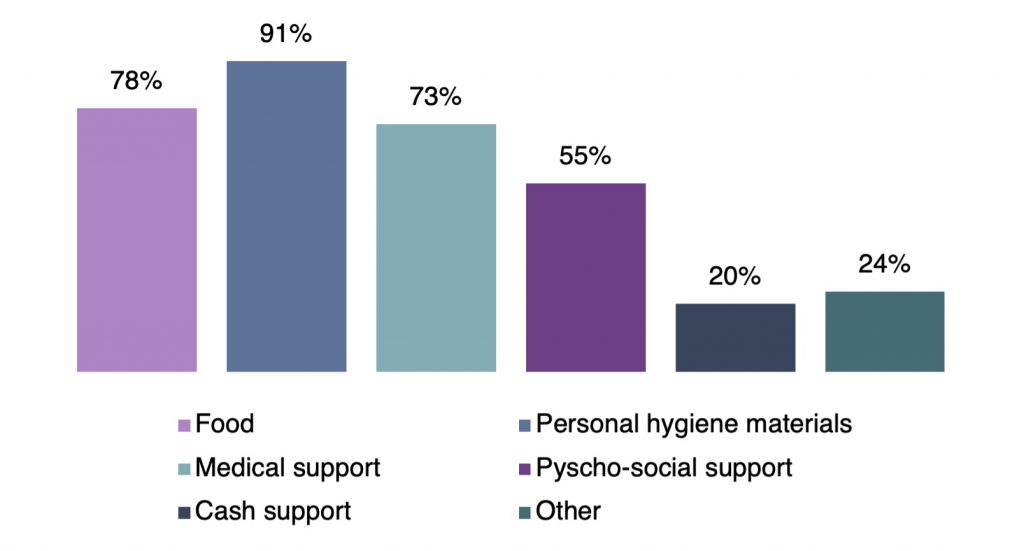
2. CSOs disseminated crucial information
Given that the CSOs that participated in the survey have extensive experience working on the ground, they were able to quickly identify and adapt to the needs of their communities.

Fifty-five percent of CSOs created IEC materials by translating them into local languages.
Approximately 74 percent conducted door-to-door visits to disseminate relevant information to the communities. Fifty-five percent created customised information, education, and communication (IEC) materials by translating them into local languages. Ninety-five percent provided information about COVID-19 appropriate behaviour such as wearing masks, washing hands, using sanitiser, and social distancing.
More than 50 percent of the respondents disseminated information about access to medicines and medical support. They provided information about the availability of doctors, hospital beds, quarantine centers, oxygen cylinders, and drugs such as Remdesivir. Sixty-three percent of them provided information about COVID-19 vaccines.
More than 50 percent of the CSOs provided information about documents required, such as an Aadhaar card, so that intended beneficiaries could access government schemes and benefits. Approximately 75 percent disseminated information about existing government schemes.
What was the impact of the second wave?
1. Challenges faced by women
The COVID-19 pandemic has posed a diverse set of challenges for women, severely impacting their economic, physical, and mental well-being. These are some of the challenges captured by the survey:
- Juggling household chores, caregiving responsibilities, and work
- Increased incidences of domestic violence and harassment
- Health challenges faced by the elderly
- Concerns about early marriage due to the economic and social impacts of the pandemic and related lockdowns
- Lack of access to adequate nutrition for adolescent girls
- Lack of access to essentials including rations and personal hygiene materials such as sanitary pads
2. Challenges faced by the working class
Survey respondents reported widespread job losses due to the pandemic, rising cost of living, and financial crises within families in the second wave of the pandemic.
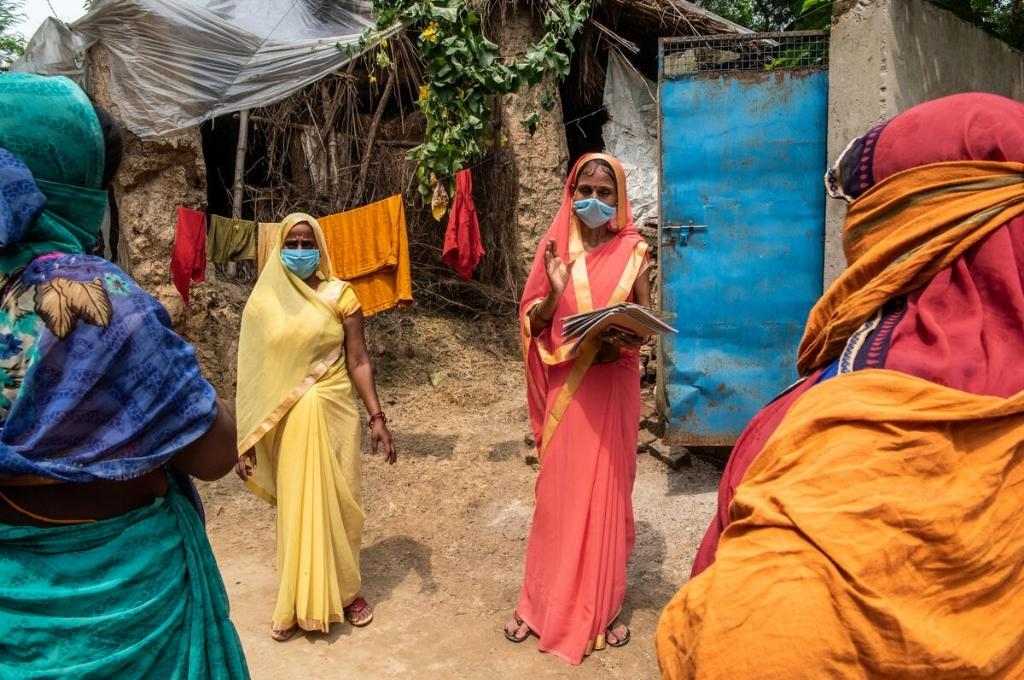
Large populations of migrant workers were forced back to their villages, while those migrants who chose to stay struggled to access welfare support. The elderly reported irregularities in receiving their pensions and other social security provisions. Further, CSOs reported having to attend to cases of depression, anger, and stress due to loneliness and self-isolation.
3. Challenges faced by adolescents and persons with disabilities
Respondents indicated that there were sharp inequalities in accessing education and health services among adolescents. Adolescent sexual and reproductive health and access to nutrition and meals as a part of the mid-day meals programmes in schools have been adversely affected.
People with disabilities have largely been excluded from government relief measures in the face of the pandemic.
Access to education has been limited in areas with poor internet connectivity and for those without access to smartphones. Dropout rates among adolescents living in rural areas have particularly increased, making them more vulnerable to child labour and exploitation.
People with disabilities have largely been excluded from government relief measures in the face of the pandemic. They have faced widespread hunger, neglect, and limited access to healthcare support. Other issues include difficulty accessing pensions, securing rations, neglect from family members and society at large, securing vaccination slots, and inability to access transportation facilities. Accessing information was particularly difficult for persons with visual impairment, hearing impairment, or those who suffered from intellectual disabilities.
4. Challenges faced by CSOs
a. Under-resourced, under-staffed, and under-protected
Ninety-two percent of CSOs reported that unavailability of financial resources was the biggest challenge they faced while responding to the second wave of COVID-19. This financial crunch curtailed their operations. Further, approximately 75 percent of the CSOs reported that their relief efforts were hindered by restricted mobility due to lockdowns and curfews.
Out of the 577 respondents, 205 reported instances of sickness faced by their staff because of contracting COVID-19, while 54 CSOs reported an occurrence of death among their staff. Forty-four percent reported sickness of staff to be a significant problem. Fifty-three percent highlighted that the lack of human resources posed a challenge to the smooth functioning of their organisations. More than half the CSOs reported that they faced an inadequate supply of safety gear for their staff.
Other challenges reported by CSOs include lack of support from the local government, mental stress faced by staff members, and delays in reaching remote locations to carry out relief efforts.
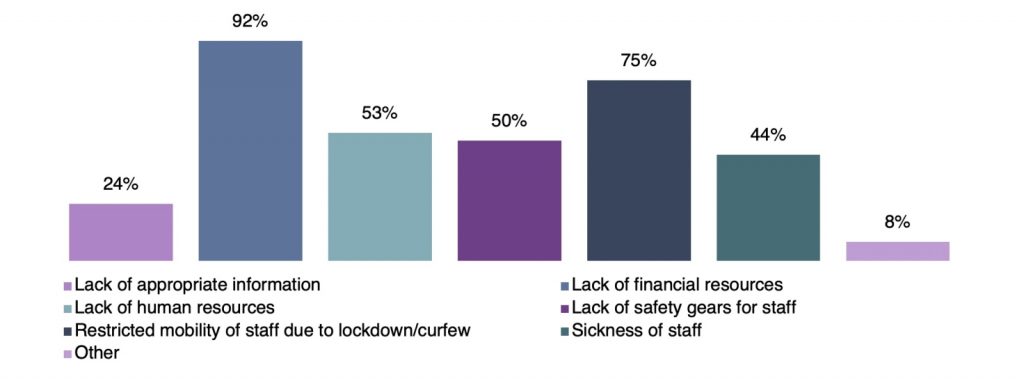
b. Lack of donor support, access to resources, and cooperation
Seventy-eight percent of the respondents reported lack of donor support or flexibility to be a major challenge. Forty-two percent reported having to use their own resources to engage in relief and community support activities. Further, 40 percent were unable to raise any new resources to support ongoing relief work. Only seven percent managed to receive CSR funding for pandemic disaster alleviation during the second wave of COVID-19. Six percent were able to mobilise community resources for their efforts. Lastly, only six percent of resources raised for relief purposes came from foreign donor contributions (individual and organisational donations) and assistance from the Indian diaspora.
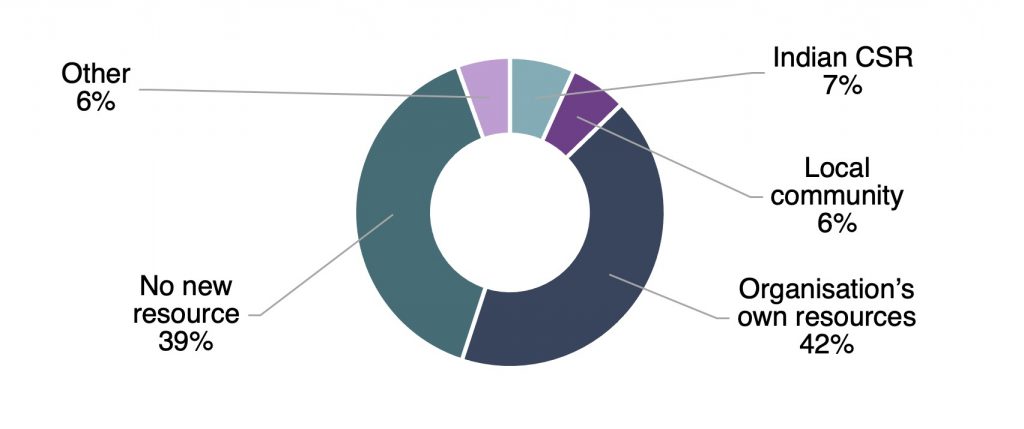
More than 50 percent of the CSOs also reported facing trouble procuring relief materials from the market due to the lockdown and curfews. Critical to accessing markets and communities was coordination between CSOs and Panchayati Raj Institutions, municipalities, and block and district administrations. However, nearly one-third of the CSOs reported a lack of cooperation from these bodies when conducting relief operations on the ground.
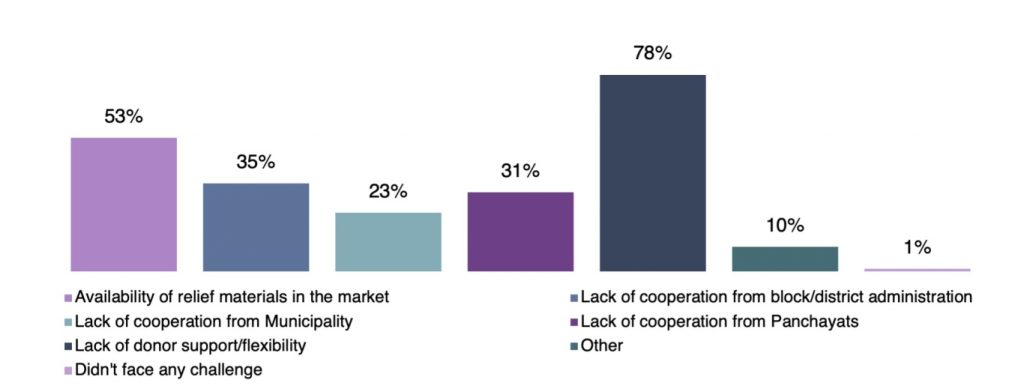
The second wave of COVID-19 has wreaked devastation in rural and urban communities across India. Despite facing immense challenges of their own, CSOs across the country came together to respond to the needs of the communities in which they work. Given the scale of the crisis, their presence has been vital to ensuring that communities have access to basic necessities and resources like personal hygiene supplies, rations, medical support, and more. Going forward, this raises important strategic questions about how CSOs can be better supported by donors and the government.
—
Know more
- Read this research paper about CSO interventions during the pandemic at a local, state, and national level.
- Read about how the impact of CSOs at a grassroots and policy level calls for a more tolerant and cooperative approach towards their functioning by the government.
- Read this report about India’s capacity building landscape for CSOs and recommendations on how to improve their functioning post the pandemic.



